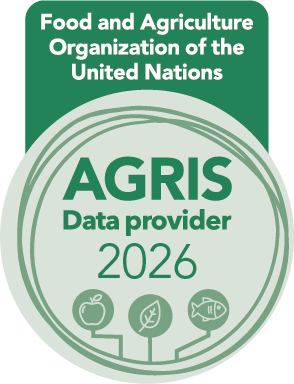Bio-efficacy of Annona formulation for the management ofAphis gossypii on vegetable crops
DOI:
https://doi.org/10.24154/jhs.v20i1.2344Keywords:
Aphids, bitter gourd, botanicals, cucumber, IPM, vegetablesAbstract
Field experiments were conducted to optimize the dose and assess the efficacy of an Annona formulation against Aphis gossypii Glover on vegetable crops such as cucumber, bitter gourd, okra and dolichos. Based on LC50 values, different doses of the Annona formulation were evaluated specifically on bitter gourd and cucumber. The dose optimization study determined that a concentration of 3.5 ml/L of water of the Annona formulation effectively managed A. gossypii under field conditions. Subsequently, the efficacy of this dosage was further evaluated in field trials against A. gossypii in comparison with other botanicals and insecticides. The Annona formulation at 3.5 ml/L of water demonstrated significant effectiveness, reducing aphid populations by 97% compared to alternative botanicals and insecticides. This study suggests that the developed Annona formulation could serve as a promising eco-friendly approach for managing aphids on vegetable crops.
Downloads
References
Anita, S., Sujatha, P., & Prabhudas, P. (2012). Efficacy of pulverised leaves of *Annona squamosa* (L.), *Moringa oleifera* (Lam.) and *Eucalyptus globulus* (Labill.) against the stored grain pest, *Tribolium castaneum* (Herbst.). *Recent Research in Science and Technology, 4,* 19-23.
Ansante, T. F. (2015). Secondary metabolites from neotropical Annonaceae: Screening, bioguided fractionation, and toxicity to *Spodoptera frugiperda* (J.E. Smith) (Lepidoptera: Noctuidae). *Industrial Crops and Products, 74,* 969-976. [https://doi.org/10.1016/j.indcrop.2015.05.058](https://doi.org/10.1016/j.indcrop.2015.05.058)
https://doi.org/10.1016/j.indcrop.2015.05.058
Baldin, E. E. L., Soares, M. C. E., Santana, A. S., Hunt, T. E., Justin, M., Arango, A. M. V., & Louis, J. (2023). Efficacy of ethanolic seed extracts of *Annona* spp. against *Aphis glycines*. *Crop Protection, 170,* 106268. [https://doi.org/10.1016/j.cropro.2023.106268](https://doi.org/10.1016/j.cropro.2023.106268)
https://doi.org/10.1016/j.cropro.2023.106268
Chakraborty, N., Mitra, R., Pal, S., Ganguly, R., Acharya, K., Minkina, T., Sarkar, A., & Keswani, C. (2023). Biopesticide consumption in India: Insights into the current trends. *Agriculture, 13,* 557. [https://doi.org/10.3390/agriculture13030557](https://doi.org/10.3390/agriculture13030557)
https://doi.org/10.3390/agriculture13030557
Dedryver, C. A., Ralec, A. L., & Fabre, F. (2010). The conflicting relationships between aphids and men: A review of aphid damage and control strategies. *Comptes Rendus Biologies, 333,* 539-553. [https://doi.org/10.1016/j.crvi.2010.03.009](https://doi.org/10.1016/j.crvi.2010.03.009)
https://doi.org/10.1016/j.crvi.2010.03.009
Dela, M. A., Koffivi, K. G., Komina, A., Arnaud, A., Philippe, G., & Adole, G. I. (2014). Evolution of neem leaves based preparation as insecticidal agent against the green peach aphids, *Myzus persicae* (Sternorrhyncha: Aphididae). *African Journal of Agricultural Research, 9*(17), 1334-1352. [https://doi.org/10.5897/AJAR2013](https://doi.org/10.5897/AJAR2013)
Durairaj, D., & Jyoti, B. (2023). A method to optimize the pesticide dose considering the combined influence of plant, pest, pesticide, and spray equipment on bioefficacy. *Spanish Journal of Agricultural Research, 21*(3), 208-209. [https://doi.org/10.5424/sjar/2023213-19738](https://doi.org/10.5424/sjar/2023213-19738)
https://doi.org/10.5424/sjar/2023213-19738
Isman, M. B. (2006). Botanical insecticides, deterrents, and repellents in modern agriculture and an increasingly regulated world. *Annual Review of Entomology, 51,* 45-66. [https://doi.org/10.1146/annurev.ento.51.110104.151146](https://doi.org/10.1146/annurev.ento.51.110104.151146)
https://doi.org/10.1146/annurev.ento.51.110104.151146
Mondal, P., Biswas, S., Pal, K., & Ray, D. P. (2018). *Annona squamosa* as a potential botanical insecticide for agricultural domains: A review. *International Journal of Bio-resource Science, 5*(1), 81-89. [https://doi.org/10.30954/2347-9655.01.2018.11](https://doi.org/10.30954/2347-9655.01.2018.11)
https://doi.org/10.30954/2347-9655.01.2018.11
Pereira, S. G., Sanaveerappanavar, V. T., & Murthy, M. S. (2006). Geographical variation in the susceptibility of the diamondback moth *Plutella xylostella* L. to *Bacillus thuringiensis* products and acylurea compounds. *Resistant Pest Management, 15,* 26.
Prasannakumar, N. R., Krishna Moorthy, P. N., & Saroja, S. (2013). Efficacy of botanicals against major insect pests of cabbage (*Brassica oleracea* var. *capitata*). *Pest Management in Horticultural Ecosystems, 19*(1), 27-32.
Prasannakumar, N. R., Jyothi, N., Saroja, S., & Ram, K. G. (2021a). Relative toxicity and insecticide resistance of different field populations of tomato leaf miner, *Tuta absoluta* (Meyrick). *International Journal of Tropical Insect Science, 41,* 1397-1405. [https://doi.org/10.1007/s42690-020-00334-1](https://doi.org/10.1007/s42690-020-00334-1)
https://doi.org/10.1007/s42690-020-00334-1
Prasannakumar, N. R., Rao, V. K., Jyothi, N., Saroja, S., & Shivarama Bhat, P. (2021b). Evaluation of some leaf and seed extracts for their insecticidal properties against *Aphis gossypii* Glover (Hemiptera: Aphididae). *Pest Management in Horticultural Ecosystems, 27*(1), 95-97.
https://doi.org/10.5958/0974-4541.2021.00018.7
Prasannakumar, N. R., Rao, V. K., Jyothi, N., Saroja, S., Lokesha, A. N., & Ramkumar, G. (2023). Evaluation of insecticidal properties of botanicals for sustainable management of sucking pests of horticultural crops. *Journal of Applied Entomology, 147*(2), 105-115. [https://doi.org/10.1111/jen.13092](https://doi.org/10.1111/jen.13092)
https://doi.org/10.1111/jen.13092
Ribeiro, L. P., et al. (2014). Comparative toxicity of an acetogenin-based extract and commercial pesticides against citrus red mite. *Experimental and Applied Acarology, 64,* 87-98. [https://doi.org/10.1007/s10493-014-9810-2](https://doi.org/10.1007/s10493-014-9810-2)
https://doi.org/10.1007/s10493-014-9810-2
Roger, C. R., Vincent, C., & Arnason, J. T. (2012). Essential oils in insect control: Low-risk products in a high-stakes world. *Annual Review of Entomology, 57,* 405-424. [https://doi.org/10.1146/annurev-ento-120710-100554](https://doi.org/10.1146/annurev-ento-120710-100554)
https://doi.org/10.1146/annurev-ento-120710-100554
Samada, L. H., & Tambunan, U. S. F. (2020). Biopesticides as promising alternatives to chemical pesticides: A review of their current and future status. *Journal of Biological Sciences, 20*(2), 66-76. [https://doi.org/10.3844/ojbsci.2020.66.76](https://doi.org/10.3844/ojbsci.2020.66.76)
https://doi.org/10.3844/ojbsci.2020.66.76
Souto, A. L., Sylvester, M., Tolke, E. D., Tavares, J. F., Barbosa-Filho, J. M., & Cebrian-Torrejón, G. (2021). Plant-derived pesticides as an alternative to pest management and sustainable agricultural production: Prospects, applications and challenges. *Molecules, 26,* 4835. [https://doi.org/10.3390/molecules26164835](https://doi.org/10.3390/molecules26164835)
https://doi.org/10.3390/molecules26164835
Tudi, M., Ruan, D. H., Wang, L., Lyu, J., Sadler, R., Connell, D., Chu, C., & Phung, D. T. (2021). Agriculture development, pesticide application and its impact on the environment. *International Journal of Environmental Research and Public Health, 18,* 1112. [https://doi.org/10.3390/ijerph18031112](https://doi.org/10.3390/ijerph18031112)
Downloads
Published
Data Availability Statement
NA
Issue
Section
License
Copyright (c) 2025 N R Prasanna Kumar, Keshav Rao Vala, N Jyothi, S Saroja, Shivarama Bhat (Author)

This work is licensed under a Creative Commons Attribution-NonCommercial-ShareAlike 4.0 International License.
Authors retain copyright. Articles published are made available as open access articles, distributed under the terms of the Creative Commons Attribution-NonCommercial-ShareAlike 4.0 International License, which permits unrestricted non-commercial use, distribution, and reproduction in any medium, provided the original author and source are credited. 
This journal permits and encourages authors to share their submitted versions (preprints), accepted versions (postprints) and/or published versions (publisher versions) freely under the CC BY-NC-SA 4.0 license while providing bibliographic details that credit, if applicable.







 .
. 











